When winter draws near, it's time to check your wardrobe of warm clothes and replenish it if necessary. For example, do-it-yourself knit warm socks. Learning how to knit socks is a bit more complicated than knitting a simple scarf, and this can become a kind of baptism of fire for a beginner.
p.s In the last article, we looked at how to knit socks
For beginners, it may seem difficult to work with several knitting needles at once, so we will tell you how to crochet your socks.
You will understand that this is not such a difficult matter:
- crochet a sock starts from the toe;
- gradually adding loops, the foot fits;
- the triangular heel is tied;
- the bootleg and elastic are formed.
Our article is designed for beginners - step by step described and shown in the video how to crochet socks. We will tell you what yarn you need to use to knit children's socks, and what kind of crochet is best to work with. The most difficult part in this work is to tie the heel of the sock, when you master this, you can quickly and correctly knit socks.
Having mastered the intricacies of knitting, you can put your entire family in socks. We will tell you how to knit children's and men's socks from yarn different colors with interesting patterns. Even in the summer you can knit fishnet socks from fine yarn. So, we begin our master class.
How to crochet socks. They can be of different sizes and different color. With this method of knitting, work begins with an elastic band that is crocheted with a size of 2.1 mm. Then we switch to a larger hook, 2.5 mm in size. In this case, the elastic will turn out more dense. 
Video lesson:
Crochet slippers. It’s easy to tie home slippers with a hook, and this shoe is extremely comfortable. Alize Lanagold half-woolen yarn was used, in which 240 meters of thread are needed per 100 grams. For knitting a hook number 3.5 was taken. 
Video lesson:
Knitted socks for beginners are designed for a child aged 2 - 2.5 years, who has 21 feet size. Two hooks with a diameter of 3.5 and 4.0 mm were used, since it is better to knit an elastic band with a thinner hook. Yarn - Karachay acrylic, cheap material. 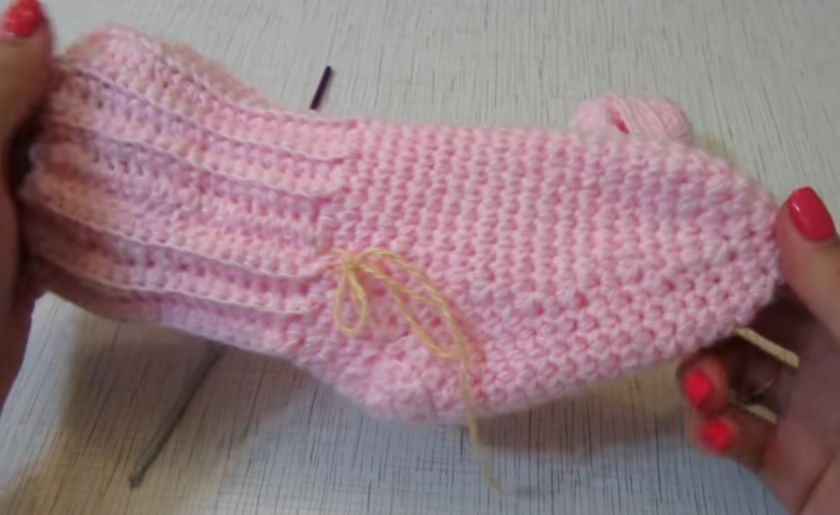
Video lesson:
How to crochet socks. Workshop on crocheting men's and women's socks. A hook number 3.5 and yarn of several colors were used to create a pattern. First, in this embodiment, the elastic is knitted, then the heel is formed. 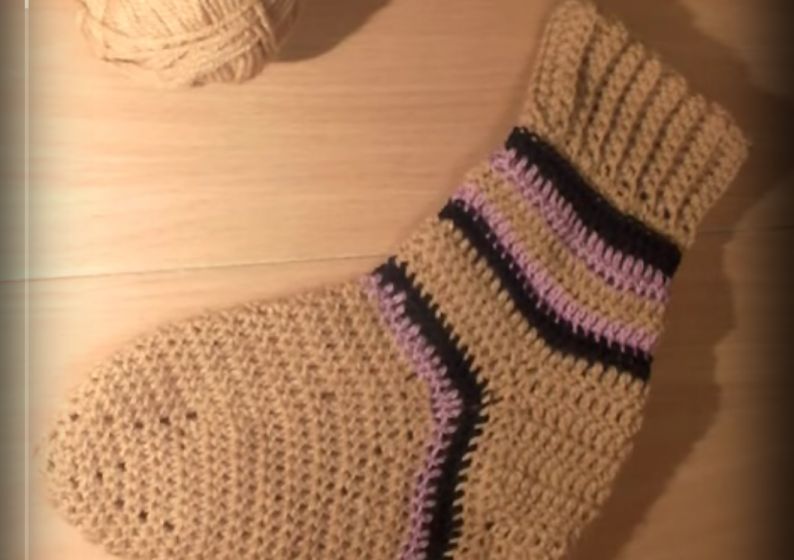
Video lesson:
How to crochet slippers. To create a home boot, five knitted elements with a beautiful pattern are used. If slippers are made instead of a boot, three of these elements will suffice. The model fits in size 37-38, although for the 36th it is quite suitable. Yarn is one hundred percent microfiber, 225 grams per 100 grams. Unlike wool, this material does not roll and lasts longer beautiful view. Hooks used number 2 and number 4. 
Video lesson:
How to crochet socks. Socks are designed for size 37. The yarn was used in two types - dark acrylic and light wool mixture, it will require approximately 80-100 grams. Work was carried out by hook number 3. Knitting is carried out from the sock with the gradual addition of loops. 
Video lesson:
Crochet socks. Work begins with the formation of an elastic band of the English type, which is knitted flat and connected with loops in the cuffs. Further knitting continues with a thread of a different color. 
Video lesson:
Crochet socks. Used hook width of 3 millimeters. The work started with an elastic band, which should stretch tightly to cover the leg. Next, the number of rows is knitted, which determines the height of the toe, after which the heel begins to form. 
Video lesson:
Simple crochet socks can start both from the sock and from the bootleg, and the heel will be tied at the end. When knitting from a sock, work is carried out with a gradual increase in their number. 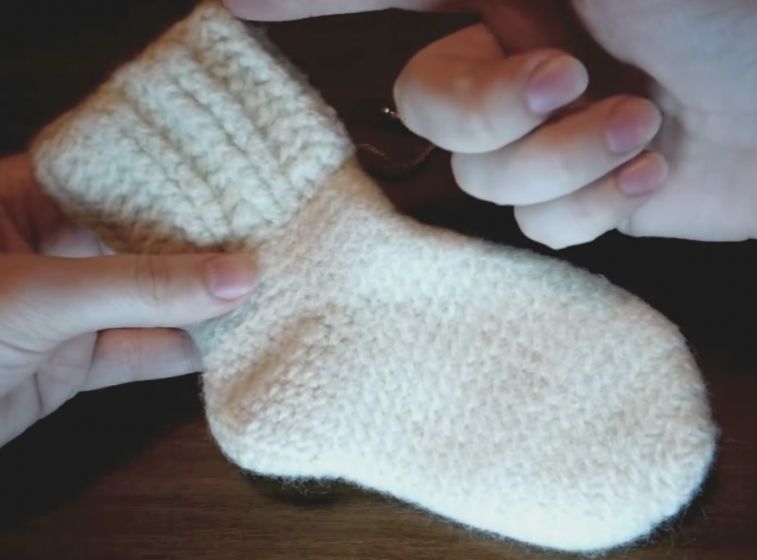
Video lesson:
How to crochet socks. The beginning of work is with an elastic band, which is tied and closed with loops. No seam is visible. Next, the heel part is formed. 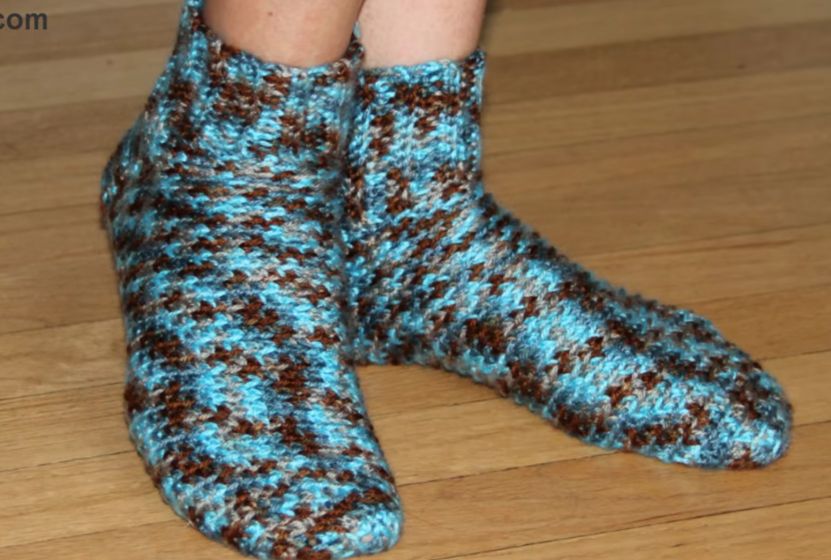
Video lesson:
Quote from Rainy77 A detailed workshop on crocheting seamless socks for the first time was published here - http://xvast.forblabla.com/blog/45408314616/Podrob...yu-besshovnyih-nosochkov-kryuc and even won a hundred rubles on the phone !!) )))
Already repeatedly showed these socks, and now MK!
By popular demand, I present to your court my own way of crocheting socks.
Of the many options, this is perhaps the simplest, even a beginner can handle it. And for those who knit - knitting such socks will take only an hour) Fast, convenient and comfortable.
That's what we get in the end

I knit in two threads (acrylic), I won’t say the number of the hook, but it’s rather thick, about 5. Next, the photo will be visible)
Next, I give my sizes (number of rows and loops) Exclusively as an example. Your performance may vary slightly or very much. It all depends on the size of the leg, the thickness of the thread, hook, etc. I have a 35th rr, about the thread and hook description above. No special skills are required, it is enough to be able to knit a regular column (without a crochet), it is not difficult to learn this, there is a ton of information on the Internet, but if suddenly it is not clear to someone, I will explain it with pleasure)
So, we make the first loop and knit 4 air loops into it, then connect it to the first connecting loop (insert the hook into the first loop, grab the working thread, stretch through all the loops on the hook. Next, we make the connecting loops as in this description).
We start knitting with the toe.

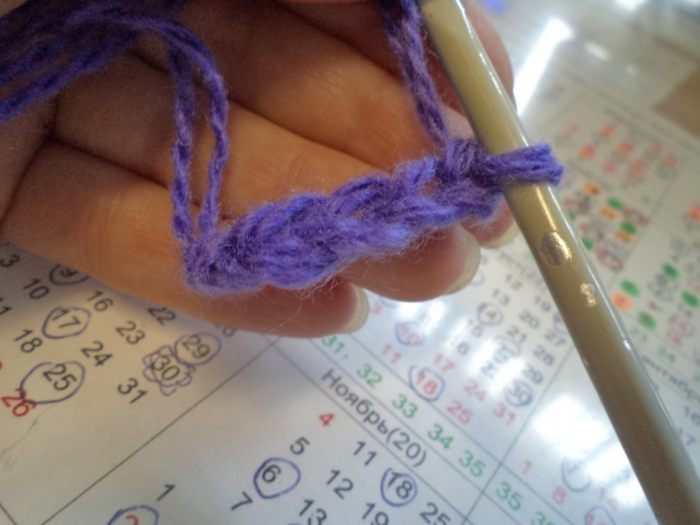

The result is such a small circle. Further, moving in a circle we knit two columns in each of the formed base loops. We knit in this way 2-3 rows. The rows in this case will be conditional, since we knit in a circle without lifting loops, we look approximately. You can put a beacon. 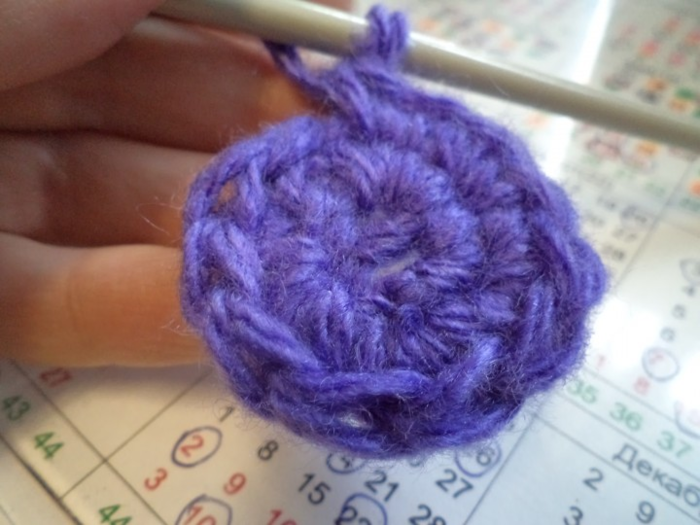
Then we knit through one - that is, in one loop of the base - one column, in the next 2 columns. Thus we add our circle. In the process, everything will become clear)
It turns out 
It is already possible to try on a leg) Smtrim that the typed loops are already enough. In my case, it turned out 22 loops. Remember the amount. In order to count - put the beacon. Advice for beginners - be sure to write down how many loops turned out !! 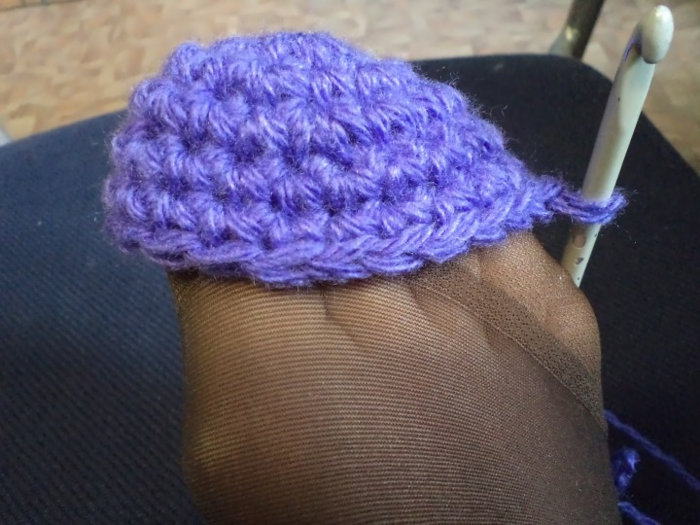
It’s better to put the beacon on with a contrasting thread, I didn’t have it at hand, sent the same one - between the loops) 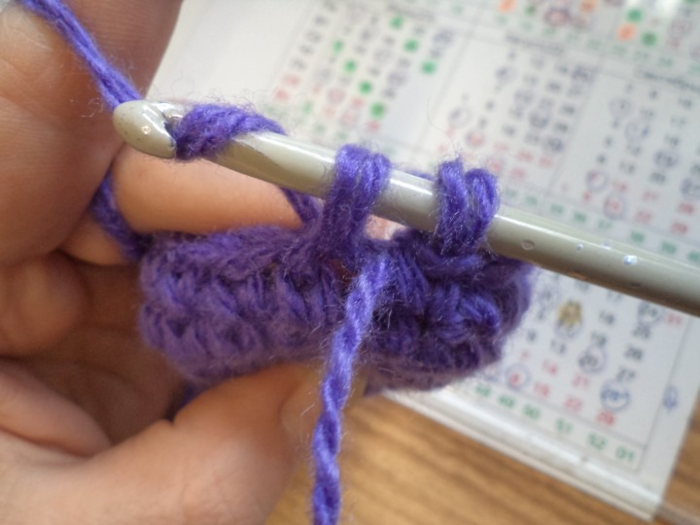
Then everything is simple - we knit in a circle, periodically trying on, to the base of the foot. 
We try on, we see that it is already long enough, we begin to knit the heel.
Advice for beginners - count and write down the number of rows so that the second sock is tied to the appropriate size! I remind you that the series are conditional, but you can count them - we start from the beginning of knitting to the base of the foot. I got 22 rows.
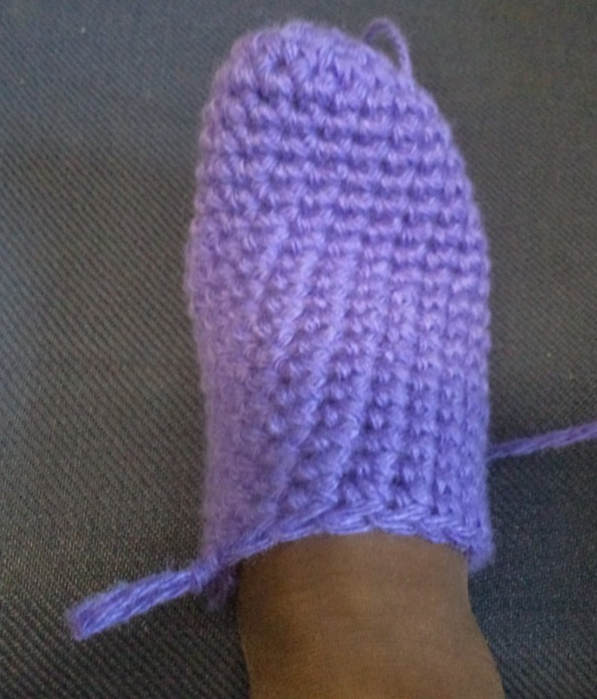
Determine the size of the hole for the leg. We estimate approximately how much we need to leave the loops so that the leg later fits into the sock. Count the loops.
Advice for beginners - on the heel it is better to leave an odd number of loops. This is not important, but, as practice shows, is reasonable)
So, I got 9 loops left on the hole. We recall - there were 22 in total. 22 - 9 \u003d 13 - the stitches remain on the heel.
The number of left loops can be noted with beacons, but to do this, in general, it is useless, since we have already calculated how many loops we knit further.
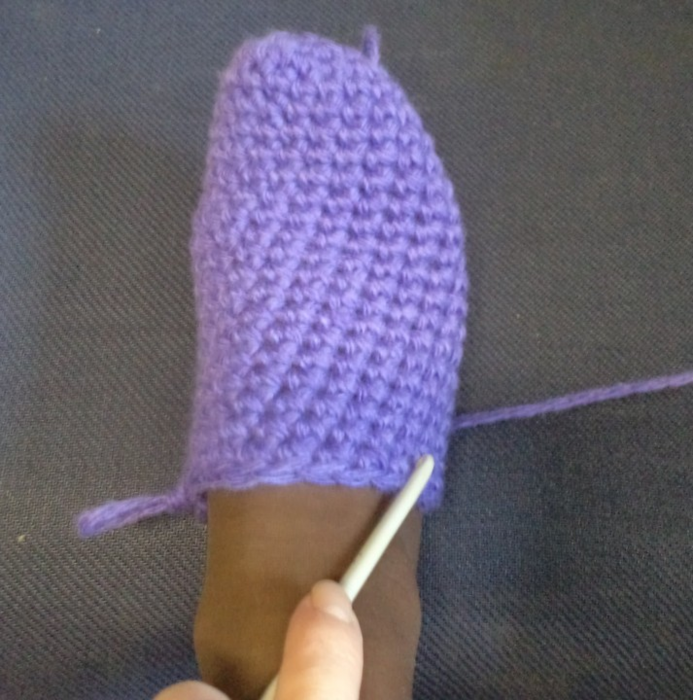
We collect two air loops into the loop on which knitting was stopped. We unfold our knitting and knit in the opposite direction.
In the same way we do, having tied the row to the end - we collect 2 air, deploy, knit.
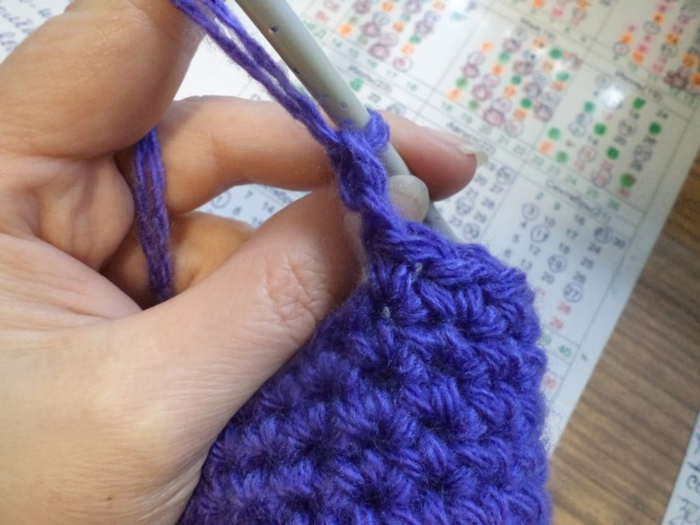
Attention!! We knit only loops left on the heel!
In my case, it's 13 loops.
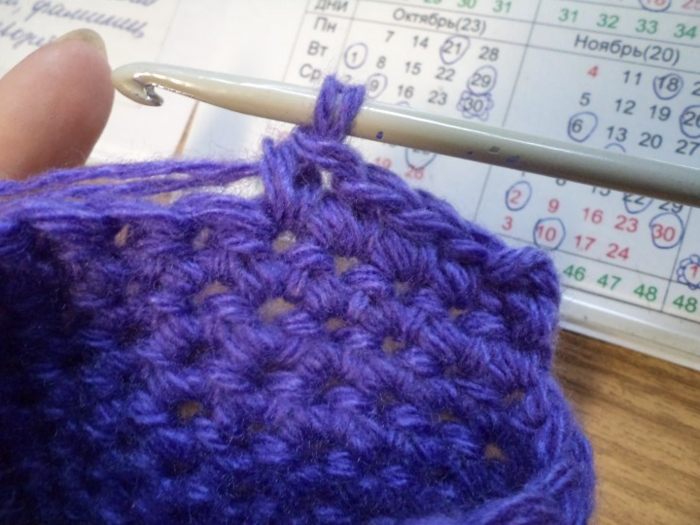
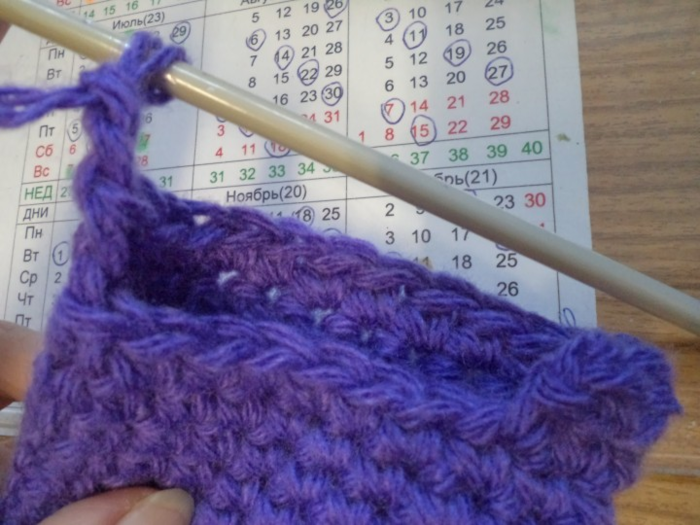
We knit the required number of rows - we try on to determine. It should be like this 
I got 7 rows. We begin to untie the heel. For this, the number of loops left on the heel is divided by 3.
In my case: 13: 3 \u003d 4 (+1) So that it’s clear why we divide by 3 - three, this is the number of sides of our heel!)) Thus, 4 loops will go along our sides and 4 +1 more - from below.
We knit the next row - the side part (4 loops), the bottom (4 loops) and make a connecting loop in the next loop of the base.
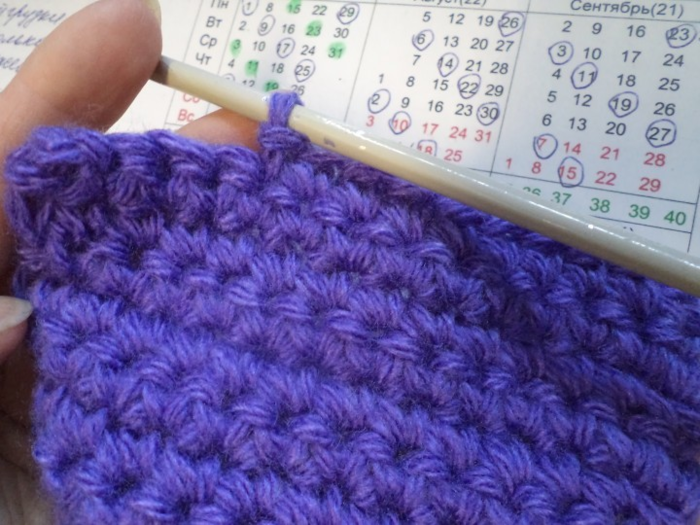
We unfold the knitting, knit the lower part (4 loops) and make a connecting loop with the next loop of the side.
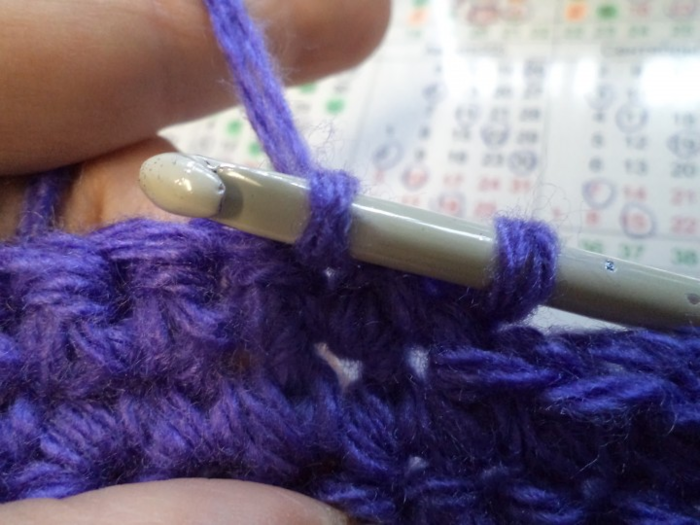
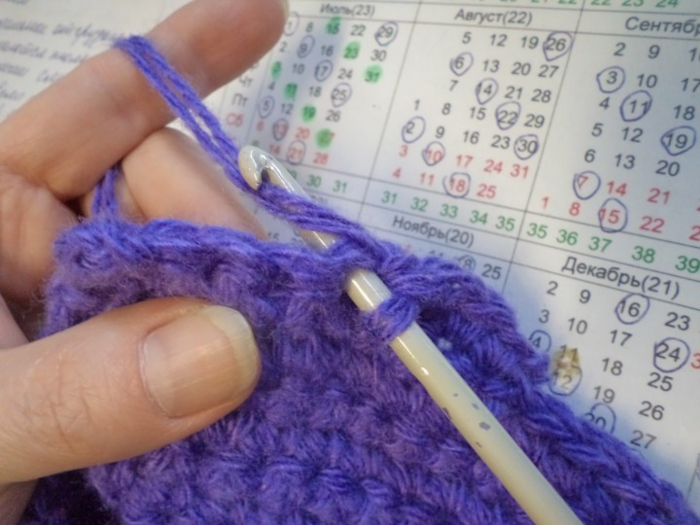
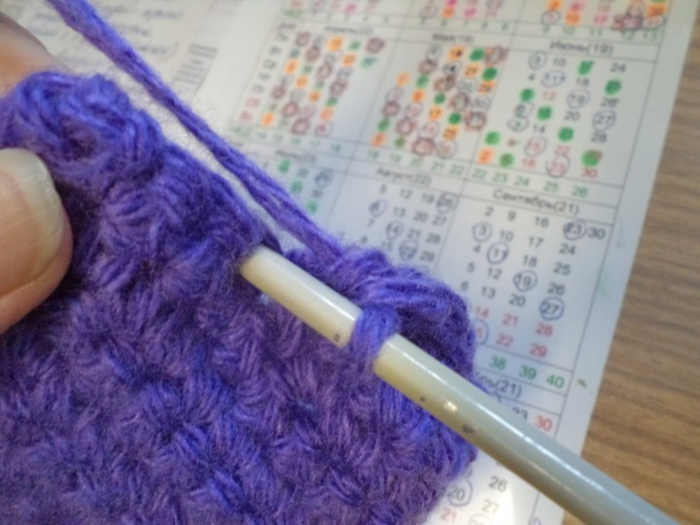
Everything, the heel is ready. We make two air lifting loops and knit again in a circle, increasing the height of the sock. 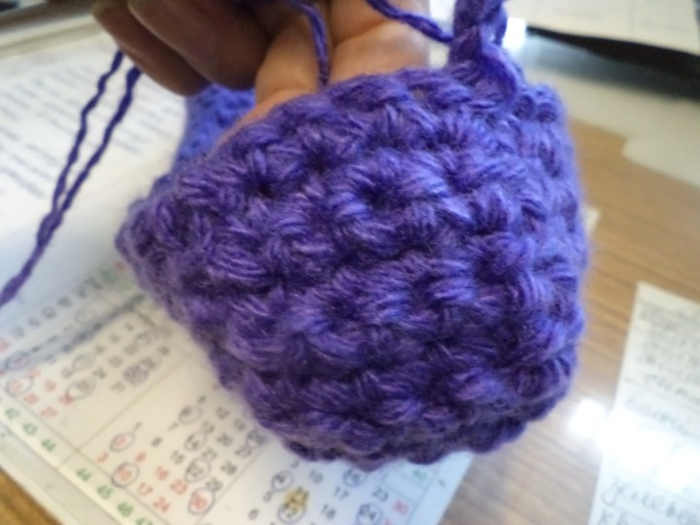
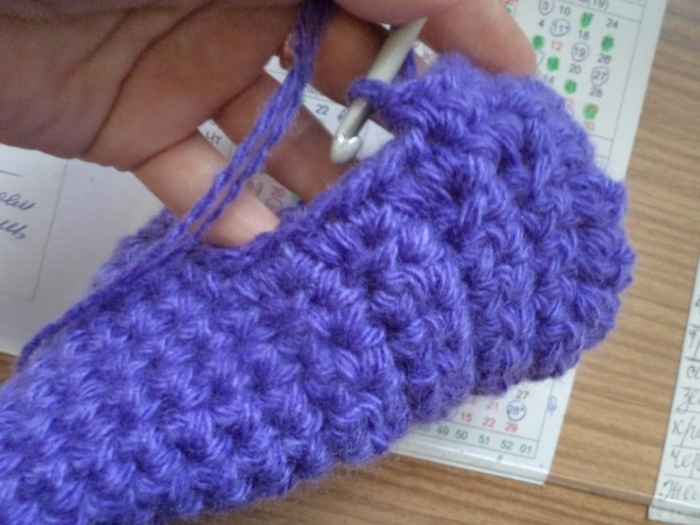
In the 2nd and 3rd row I remove one loop in the corners on the sides - for a better fit) I just do not knit them. 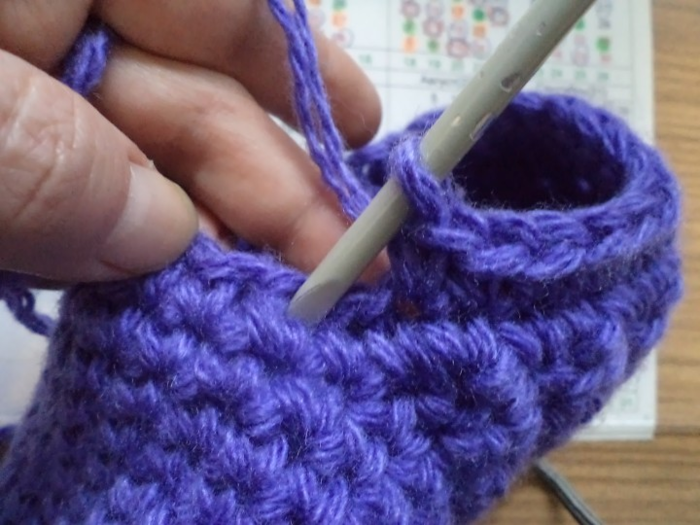
In order to quickly increase the height of the sock, I knit a series of double crochet posts. If you want high - golfs, then you can knit further, to the required height, double crochet or without. Or add some kind of picture)
To perform double crochet, you must first dial three lifting air loops at the beginning of the row.

Next, we knit a series of double crochet posts. We connect a connecting loop. 
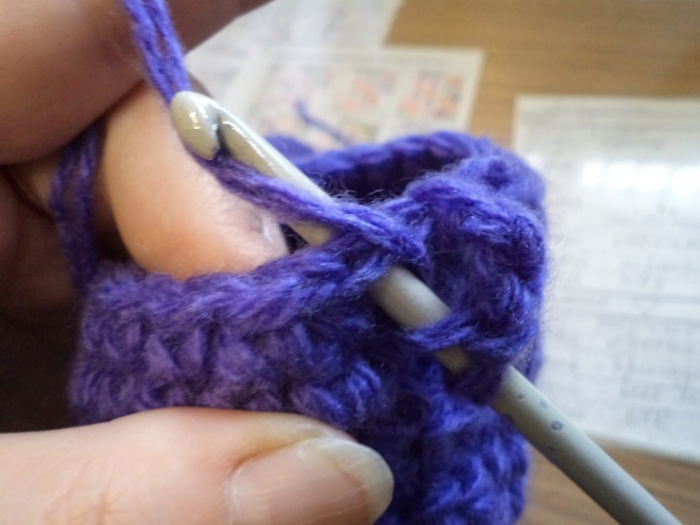
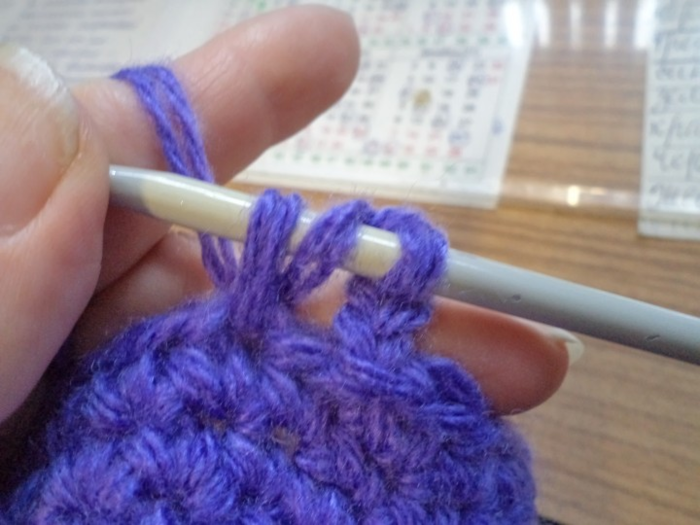

![]()
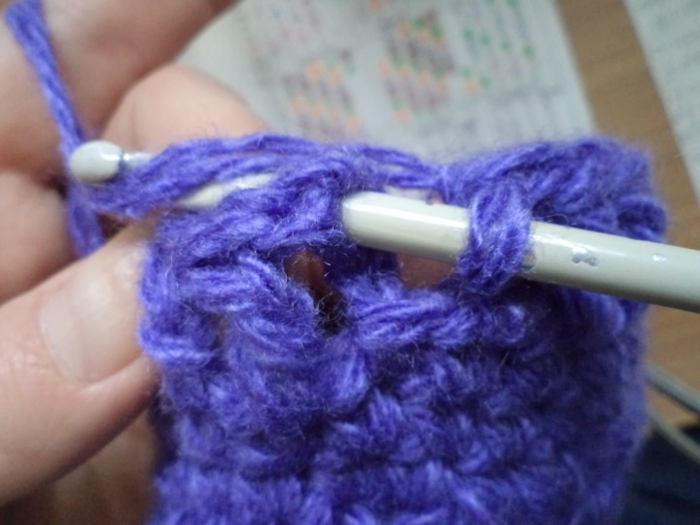
Having knitted the required number of rows, we finish knitting. 
Voila! The sock is ready !! We knit the second in his image and likeness) 

Such socks are very comfortable to wear, keep their shape perfectly, warm and comfortable)
And, most importantly, their dignity - they fit very, very quickly!


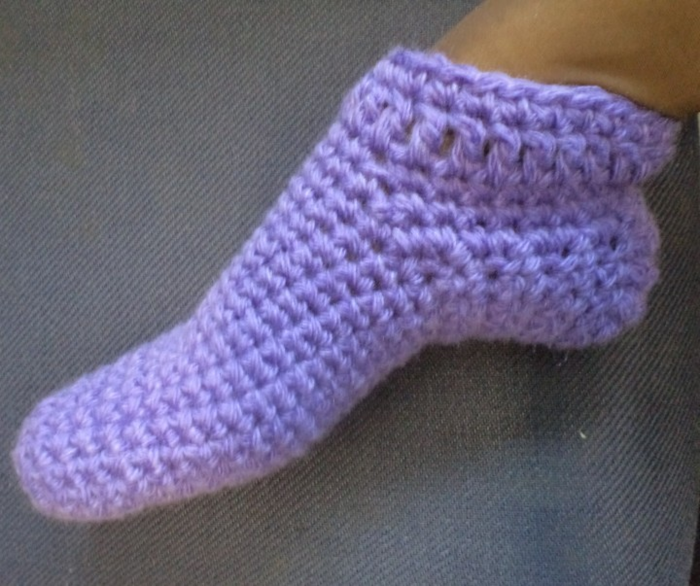
Personally, my opinion is that such socks are not only legs, but also warm the soul))
All great success and a lot of cozy, beautiful socks !!)))
Knitwear is now at its peak. And things that are made by hand have a lot of advantages: low price, good quality and unique design. It is very nice to wear a thing that is made with love. Knitting requires some skills. But, such simple little things as napkins and socks can be learned even by a novice needlewoman. Crocheted socks take precedence over knitting needles. Such things are denser and do not stretch when washing. Using the hook, you can create any design: from delicate lace to dense winter knitting. Let's look at what it takes to crochet socks.
Materials needed to crochet socks
To start knitting, we need a hook and yarn, as well as a pattern that will help you stay on the pattern.
Hooks for knitting socks are different. It all depends on the quality of the thread that is used. To knit thick and soft yarn using a wooden hook. Steel and plastic hooks are good for knitting socks. Choose the thickness of the tool based on the intended pattern. The thicker the hook - the more loops and pattern will be more voluminous. The diameter of the hook should be twice the diameter of the thread. Usually use short hooks 12-15 cm.
Yarn should be chosen based on what socks should be. Thin threads are good for summer socks or socks with a lace pattern. With the help of such threads you can knit elegant knee-highs. For winter socks, a thick woolen thread is suitable. In modern stores for needlework, an abundance of yarn from any material and a variety of colors. Some craftsmen advise preparing yarn for work. To do this, it should be washed, dried and wound in large skeins that will not be confused during operation.
Crochet Sock Patterns
These schemes will help to create socks of various designs.
- Where to start knitting socks.
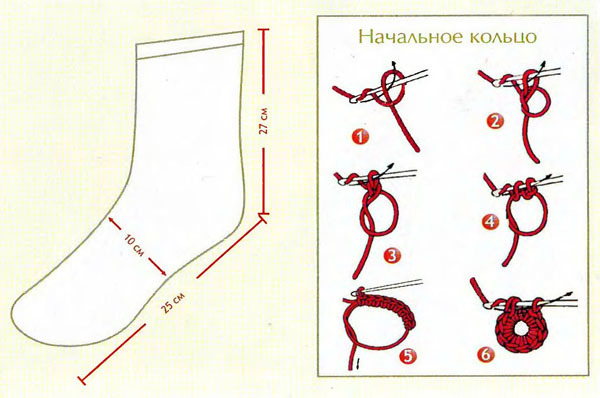
- Knitting pattern for sock details.

- Variants of patterns.
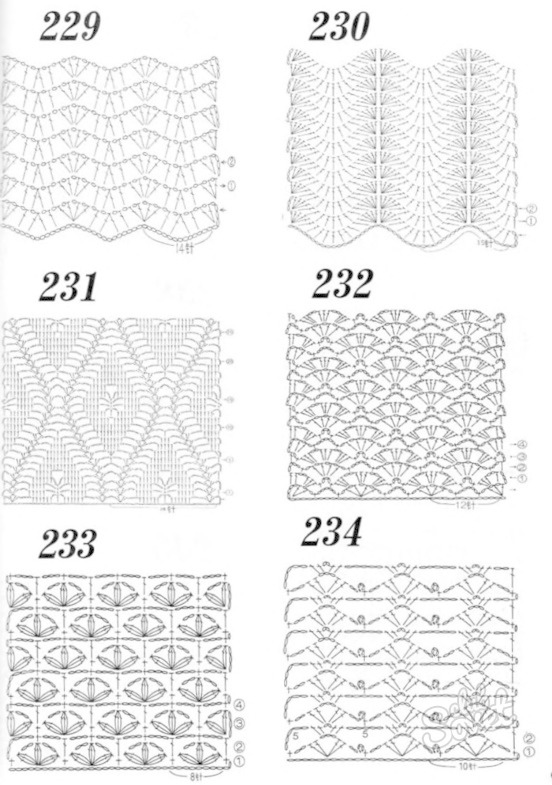
- A variant of a knitted flat sole.
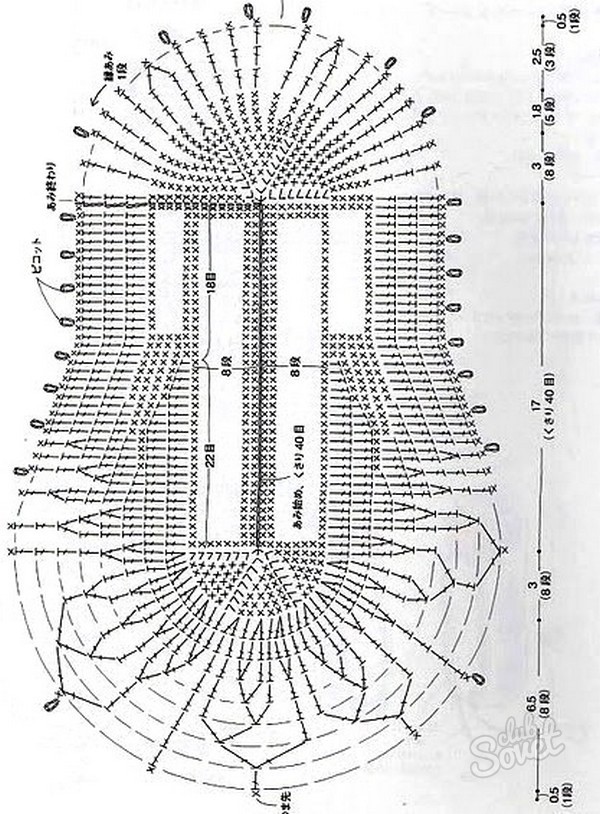
For those craftswomen who are just mastering the crochet technique, such tips will be useful:
- When crocheting, do not over tighten the loops. Knitting should be free.
- For accurate knitting, a new thread is recommended to be inserted at the end of the row.
- When knitting the initial chain, you need to knit a little more air loops so as not to stray. Excess can then be easily dissolved.
- The first knitting is best done with threads of light colors, so there is less chance of getting lost in the pattern.
- If there is no confidence in the quality of the yarn, then it must be washed before use. At the same time, it is checked which temperature regime is suitable for the future product.
- Restoring a crocheted item is difficult. To do this, you need to dissolve it, knit new columns and hide the ends.

In addition to getting a good thing, crocheting will bring a needlewoman a lot of pleasure. Crochet is much easier than knitting. And products at the same time turn out more gentle and airy.
T we knit warm flirty socks with a simple jacquard pattern and a three-dimensional pattern on the cuff.
To knit socks you will need 50 grams of white wool blend yarn of medium thickness and 100 grams of light purple, hook number 3,5.
We start knitting a sock with a set of 8 ring half-rings from a thread ring, then we tighten the ring and make a connecting loop in the 1st half-column.
To knit a pattern, we introduce a light purple thread and we knit with a simple pattern alternating 2 half columns with white thread over dark loops and 2 half columns with purple thread over white loops, knitting technique and thread change
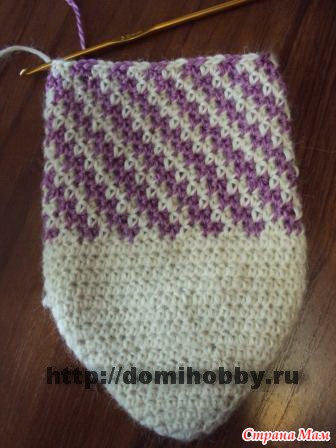
Having knitted a sock 17-18 cm from the beginning of work, continue knitting with one violet thread for another 5-6 rows, making additions of 1 additional half-column on the sides in each row.
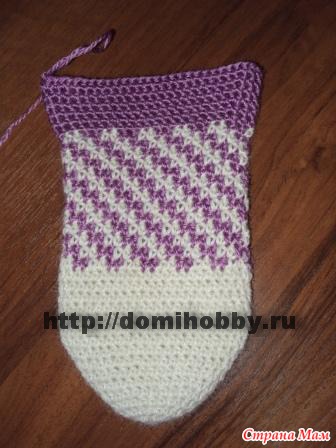
Then start knitting the heel with single crochet straight and back rows according to scheme 2 on the middle part of the sole, going to the beginning of knitting with connecting columns. When tying the heel, attach it to the toe at the same time to the middle.

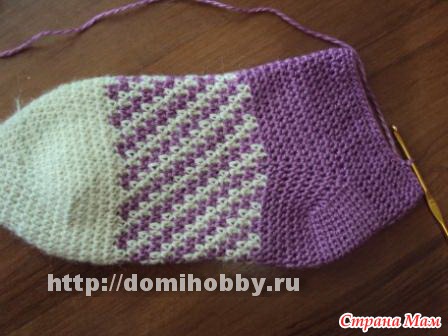
Having knitted 5-6 rows, knit a cuff with a volumetric pattern according to scheme 4, starting with 2 rows of single crochet columns.
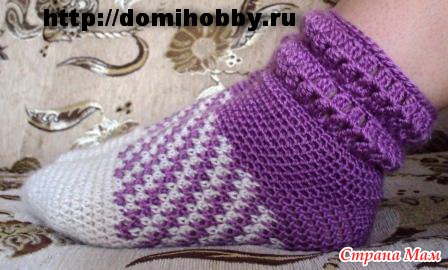
Crochet Fishnet Socks
Openwork socks are comfortable to wear in the hot season. You can learn how to crochet such elegant socks by viewing this master class in knitting socks. You will need 100 g yarn and a hook. Cotton yarn is the most pleasant to wear in hot weather, so for knitting socks, choose cotton yarn of medium thickness and a hook No. 2.5.

You need to knit socks in the following sequence: first, the toe of the sock is knitted, then the main part is made with an openwork pattern to the heel, the hole for the heel is created from an additional set of chain of air loops, along which knitting continues openwork pattern already toe cuffs. When you finish knitting the cuff, attach the thread and tie the heel in place of the heel hole.
Crochet Sock Pattern:

Now more about knitting an openwork sock according to the scheme:
Knitting toe. Dial a chain of 60 air loops and lock it into a ring with a connecting column. The opening of the initial ring should be equal to the width of the foot at the fingers.

Make 3 lift air loops and knit the first row with double crochets.
In the second row, start making reductions: 3stair. lifting point, 3 tbsp / n together (with one top), 24 tbsp / n, 3 tbsp / n together, 1 tbsp / n, 3 tbsp / n together, 24 tbsp / n, last 3 st s / n with one vertex. End each row with a connecting loop in the third lift loop.
Third row with reductions: 3 air. lifting point, 3 tbsp / n together, 18 tbsp / n, 3 tbsp / n, 3 tbsp / n together, 18 tbsp / n, last 3 tbsp / n together . As you noticed, the point of the sides is 3 air. lifting loops and double crochet before and after which decreases are made. In the next rows, make reductions, near these points, knitting together not three, but two columns together, gradually narrowing the toe to the top. After tying 6 rows of the toe, sew the remaining hole on the top or tie the connecting row, introducing the hook for half loops on both sides of the hole.
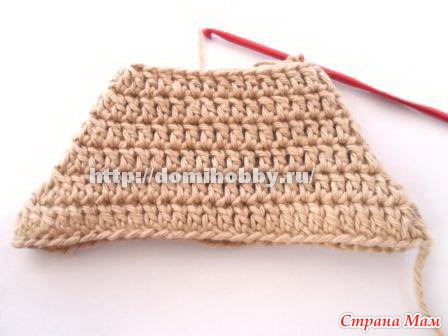

When finished, cut and fasten the thread.
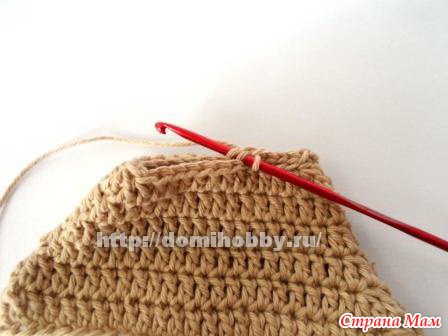
To knit the main part of the sock, attach the thread to the point where the toe begins to knit. Openwork pattern knit in a pattern in a circle, ending each row with a connecting column in the last lifting loop.
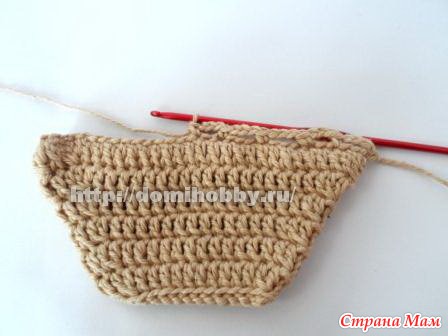
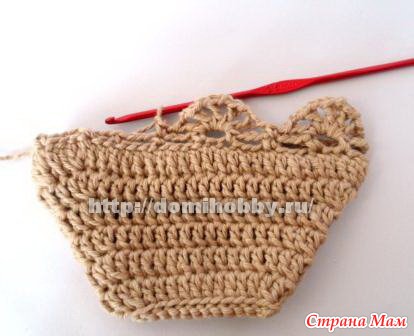
Having tied the toe to the heel and finishing the openwork pattern on the odd row, make a hole for the heel. To do this, dial a chain of 30-37 air loops, trying on the lifting legs, and secure the chain with a connecting column on the other side of the toe.
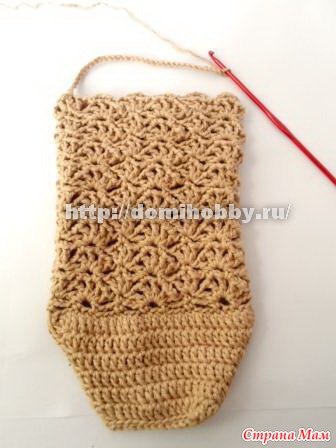
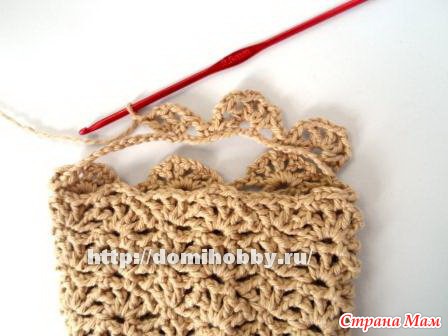
Having tied the cuff to a height of 12-14 cm, finish knitting an openwork pattern even next to the pico elements in the pattern.

The last step in knitting a sock is knitting the heel on the hole left. To do this, attach the thread to the side part (the junction of the typed chain and the main part of the sock) and make 3 air. n. lifting for knitting the first row. Knit the first row in a circle around the holes with double crochets. From the second row, start making reductions as when knitting a toe from the center of the sides. In the second and third rows, make reductions by knitting 3 double crochets together before and after the lateral point, fourth, fifth and sixth, two double crochets together.
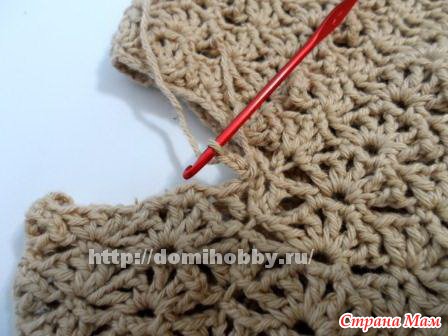
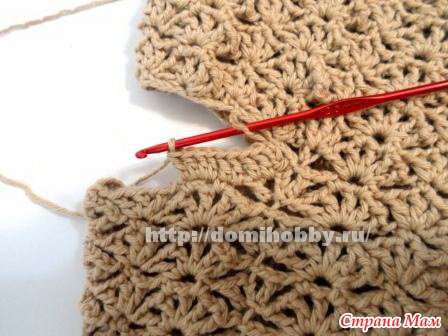

After tying the heel, sew the remaining hole or tie the connecting row. After knitting, cut and fasten the thread.
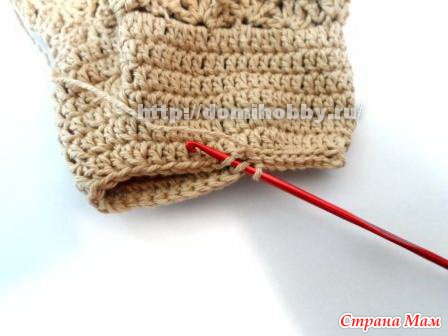
The second toe fits just like the first.
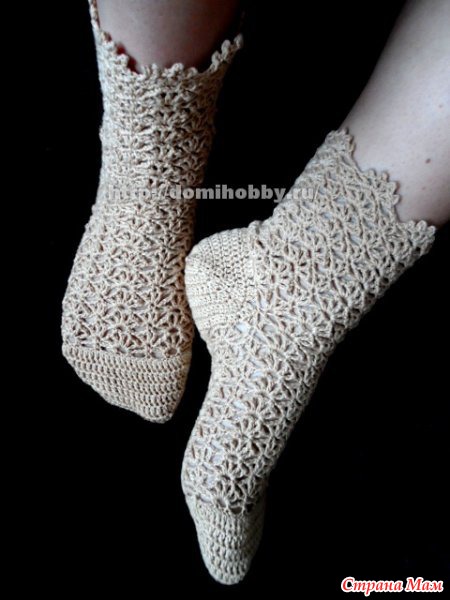
Crochet workshop
the most basic warm and comfortable socks
You will need: yarn of any thickness and a suitable hook to it.
1. Under Scheme 1, tie the toe to the widest point of the foot. Then tie a flat part to the lifting wedge, following the first table.
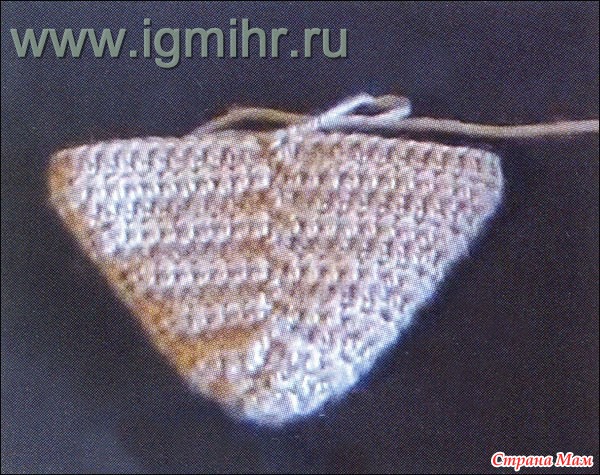
2. Using the second table, tie the required number of rows for the wedge of lifting and move the connecting loops to the beginning of knitting the heel.
3. In pattern 2, tie out the heel (each pattern indicates the number of columns for the heel).
4. Finish knitting the heel, picking up the first half-columns from the lifting wedge, and tie one row in a circle with single crochet columns.
5. Tie 3 rows of half-columns and knit the elastic out of the front and back st. s / n according to scheme 3.
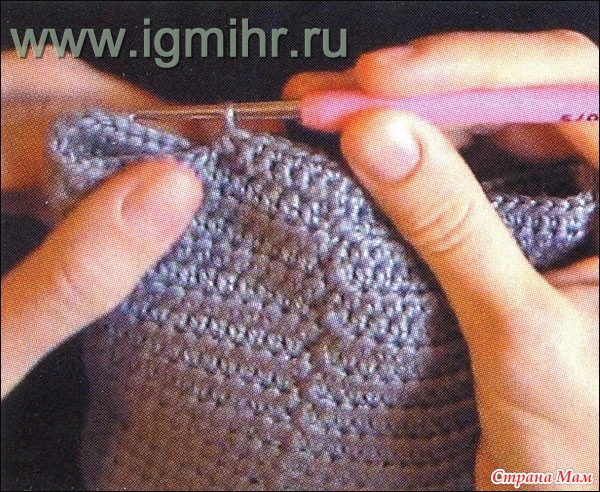
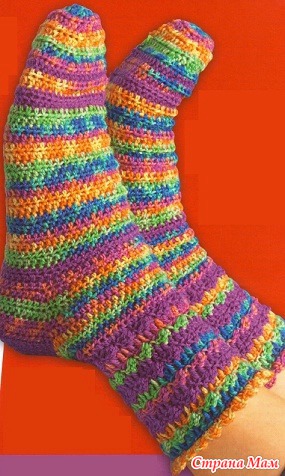
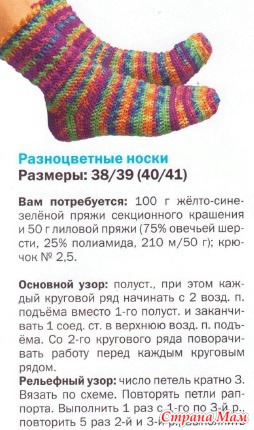
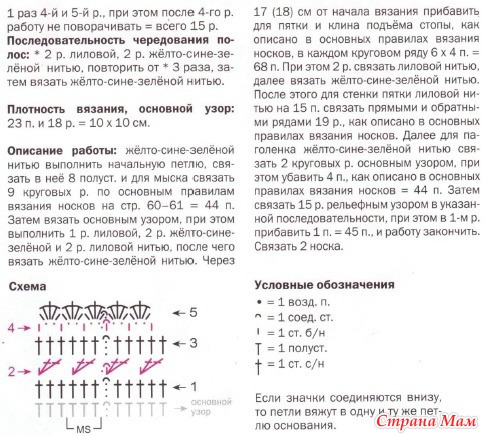

So let's get started! Knitting begins with a cuff. We collect the required number of elastic loops (I have 48) and close the connecting column in the ring.

Here's how the loops are stacked to form an elastic edge:
Unwind the end of the thread three times longer than the estimated size of the stacking row. Spread the thread on your left hand, as when sewing with knitting needles (Fig. 1). On the index finger, the thread is from the ball, and on the large free end of the thread. Insert the hook under the thread on the thumb, grab the working thread and pull out the first loop. Drop the thread from your thumb, tighten the knot. Grab the thread again with your thumb (fig. 2). Insert the hook under the thread on the thumb, grab the thread and pull out the loop. Drop the thread from your thumb, tighten the knot. There are two loops on the hook. Grab a working thread and knit these two loops. Grab the thread again with your thumb and repeat all the steps until you tie the chain of the required size.

Then we knit the elastic band in relief columns 1 * 1 in a circle.
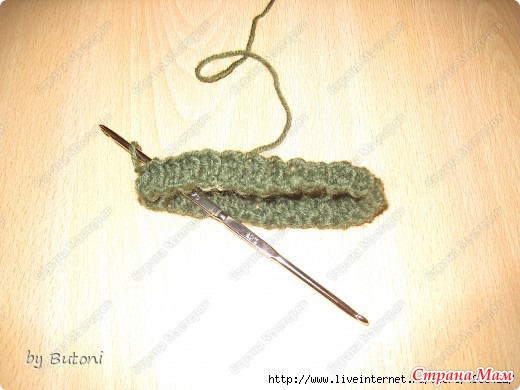
We knit to the desired size of the elastic (I have 12 cm, this is 20 rows).

Then we knit 5 rows with single crochet. also in a circle.
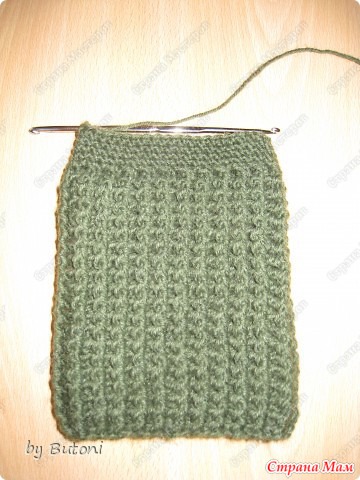
Now proceed to the formation of the heel. We knit the back straight canvas of the heel. To do this, divide the circumference of the loops in half and knit in the forward and reverse direction with single crochet (I have 18 rows).
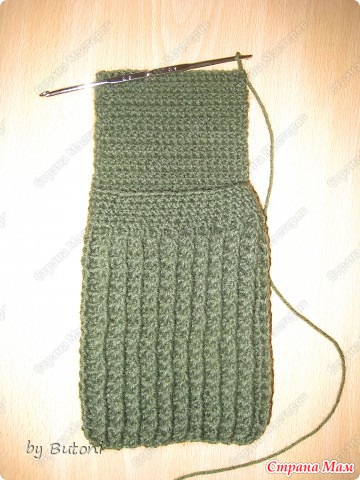
Now we divide the straight canvas of the heel into three parts (the middle one can be made larger, but the side ones should be the same) and continue to knit in the forward and reverse direction on the middle loops and attach the side parts (for this: we knit a series of middle loops. We introduce a hook from the front side under the top of the nearest loop of the side, grab the thread and pull through the loop of the canvas and the loop on the hook). Thus, the middle part will join the side. Here is the heel we got.
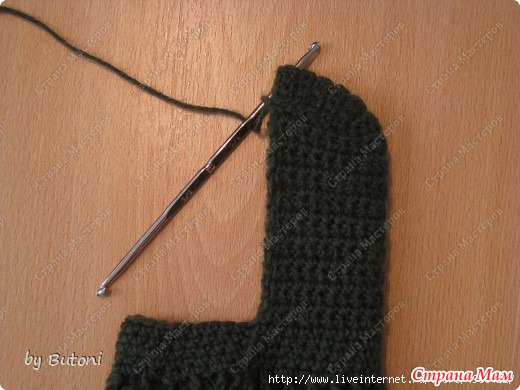
Having formed a heel, we continue to knit in a circle with crochets. To form a lifting wedge, we knit two columns with one common vertex to the right and left of the upper edge of the straight heel web. we continue the reduction to the original number of loops (I have 48 loops, I got 12 rows with contractions).

We continue to knit in a circle without changes to the base of the thumb.
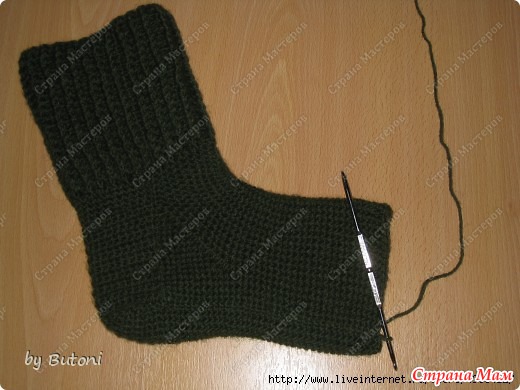
Well, the final point!
We knit a toe:
We divide the loops into 4 equal parts and knit 2 columns with one common vertex at the beginning of each quarter. Having finished cutting, thread the clippings and fasten to the wrong side!
Hurrah!!! The sock is ready.
Knit the second sock symmetrically to the first!
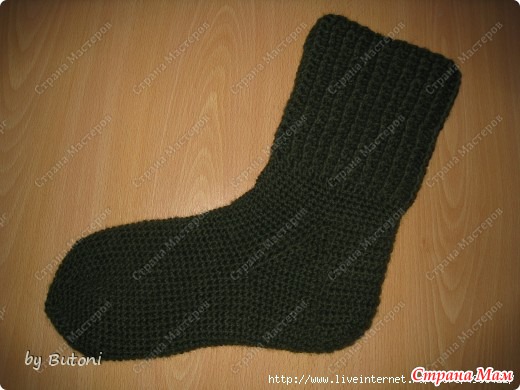
I used Finnish threads, 100g / 260m, warm and soft!
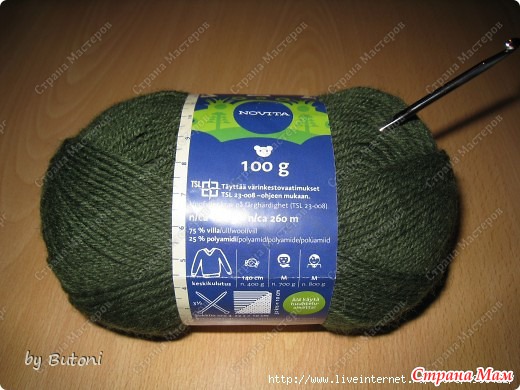
Warm socks - for dad and son
http://idi-k-nam.ru/post284220939/?upd 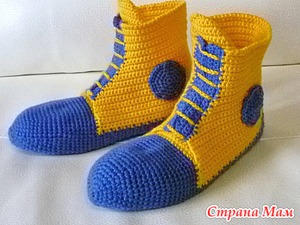
You will need (45 size - foot length 28-29cm):
Yarn "Children's whim" (60% wool, 40% acrylic, 225 m / 50 g), 100 g yellow, 100 g jeans, hook No. 3.
Knit a thread in two additions!
Main part:
In a denim color thread, tie a chain of 3 w / p, connecting in a ring.
1 row: in the center of the ring, knit 7 tbsp. non-cash
2 row: 2 tbsp. non-cash in each art. previous row.
3 row: * 1 tbsp b / n, 1 increase (2 tbsp b / n in each tbsp. Of the previous row) *
4, 6, 8, 10, 12 rows: without additions.
5 row: * 2 tbsp. non-cash, 1 increase *.
7 row: * 3 tbsp. non-cash, 1 increase *
9 row: * 4 tbsp. non-cash, 1 increase *
11 row: * 5 tbsp. non-cash, 1 increase *
13 row: * 6 tbsp. non-cash, 1 increase *. (56 p.)
14-23 rows - knit straight.
23rd row - expand the work, knit 30 tbsp. non-cash
After that, knit 8 rows as follows: knit st b / n, reducing 2 p in the middle of each row. Finish knitting. Sew on the heel.
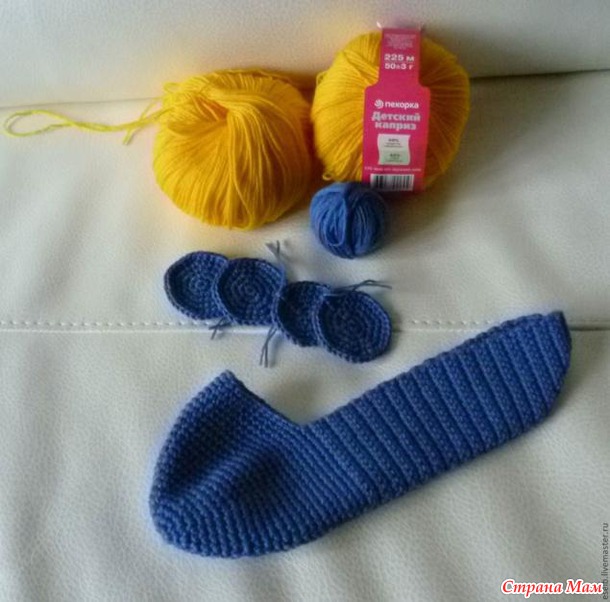
"Tongue":
Tie in the center of the line AC 16 tbsp. w / o yellow thread, knit 15 cm. In the last 4 rows, decrease at the beginning and at the end of the row for rounding.
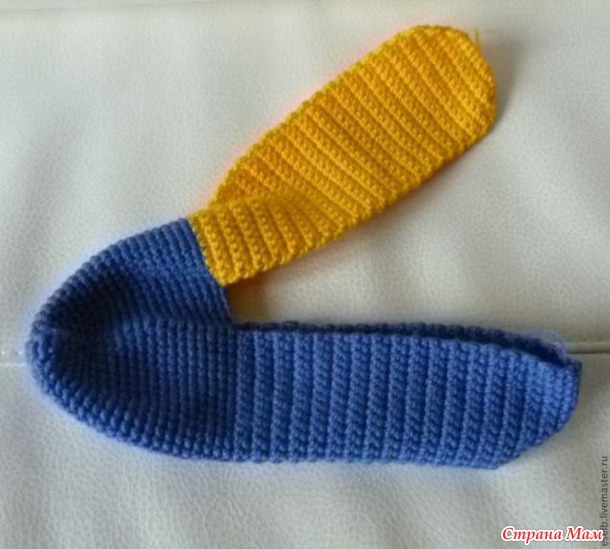
Top part:
Yellow thread on the ABC line, knit 11 rows of Art. non-cash Next, continue to knit st. b / n, not knitting at the end of each row for 3 p. Knit in this way only 4 rows. Next, knit 4 rows, not knitting at the end of each row 1 p. Then knit directly st. non-cash about 17 cm. The last row is the "step of the dog".
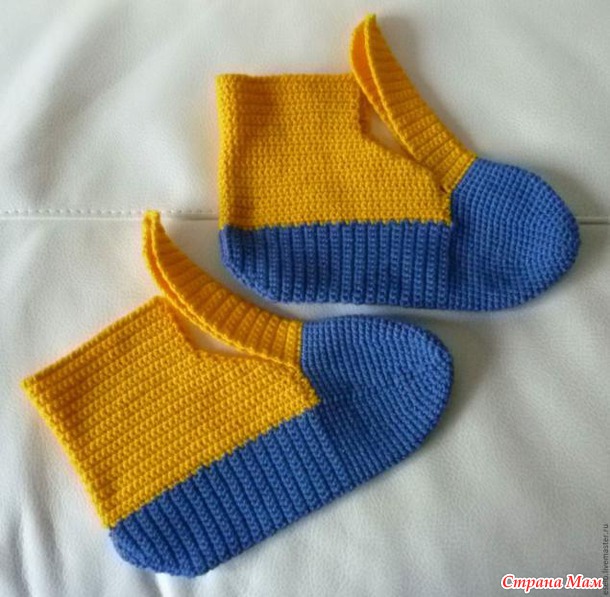
Assembly:
Tie the edges with denim 4 rows of st. non-cash
"Edges", referring to the front vertical parts of the "sneaker".
Tie the lace from the air. n. a yellow thread about 1.5 m long. Insert the cord with the hook, grabbing the “tongue” as shown in the photo. Then tie a circle with jeans, sew on.
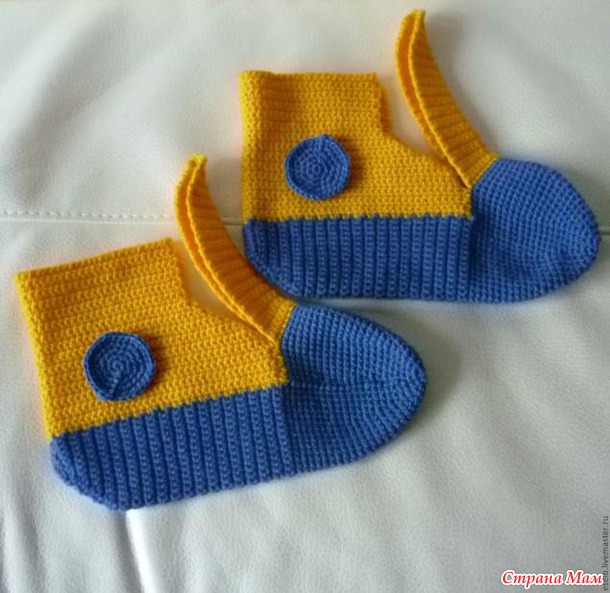
It is necessary to lace up so that the "tongue" does not hang inside, but is inside the lacing ...

Original: http: //www.garnstudio.com/lang/en/pattern.php? Id \u003d 5670 & lang \u003d en 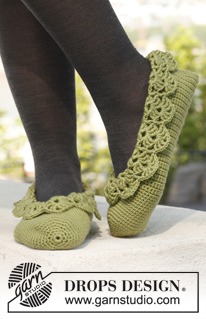
Beautiful crocheted slippers from Drops Design.
Sizes: 35/37 - 38/40 - 41/43
Foot length: 22 - 24 - 27 cm.
You will need:
Yarn DROPS NEPAL (65% wool, 35% alpaca; 75m / 50g)
Amount of yarn: 100 g color No. 0100 (white)
50 g color No. 6220 (blue)
50 g color No. 6314 (jeans blue)
50 g color No. 7120 (light gray green)
50 g color No. 7139 (gray-green)
Hook number 4.
Density of knitting: 17 tbsp. s / n \u003d 10 cm wide
In each row of Art. s / n: instead of the first art. s / n tie 3 air. p., finish the row with 1 conn. item in the third air. P.
In each row of Art. b / n: instead of the first article w / n tie 1 air. p., finish the row with 1 conn. n. in the first air. P.
Stripes
Knit by pulling a white thread from the wrong side, thread other colors to cut after each strip.
1 row of Art. non-woven thread of light gray green
1 row of Art. b
Women's hobbies

Looking for a simple and quick crochet? Spend a couple of evenings knitting socks for the baby.
If you have chosen among hundreds of hobbies, we suggest you start with simple and small models - this way you will quickly see the result and be inspired by new exploits. When a family has a baby, you can replenish a new wardrobe with a new thing. For example, to crochet these children's socks, for beginner knitters this model will prove to be feasible. Follow the step by step description and photo.
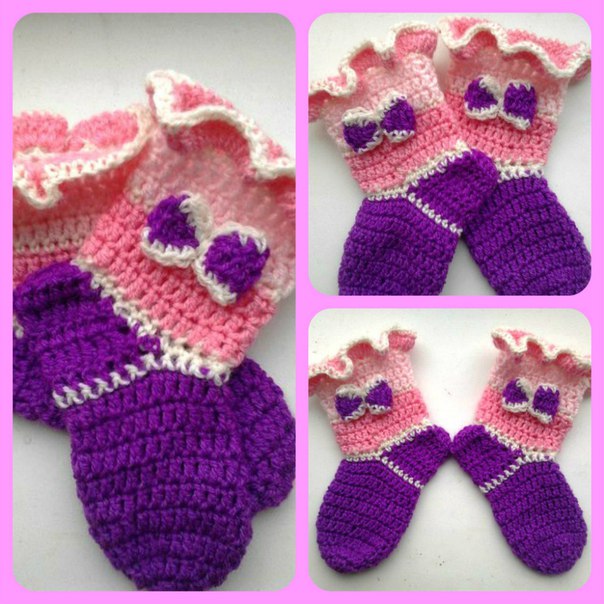
For knitting children's socks you will need:
- hook number 3.5–4;
- yarn of several colors.
This model is based on 2 basic skills: knitting in a circle and the ability to knit crocheted columns. The number of loops and calculations are presented for the children's foot 12–13 cm in size.
The first stage consists of forming a circle. Make a sliding loop, inside which dial 2 lifting loops. In a loop circle, knit 11 columns with one yarn each and end the row with a loop of connection. You should get a sliding loop with 12 columns, which should be tightened.
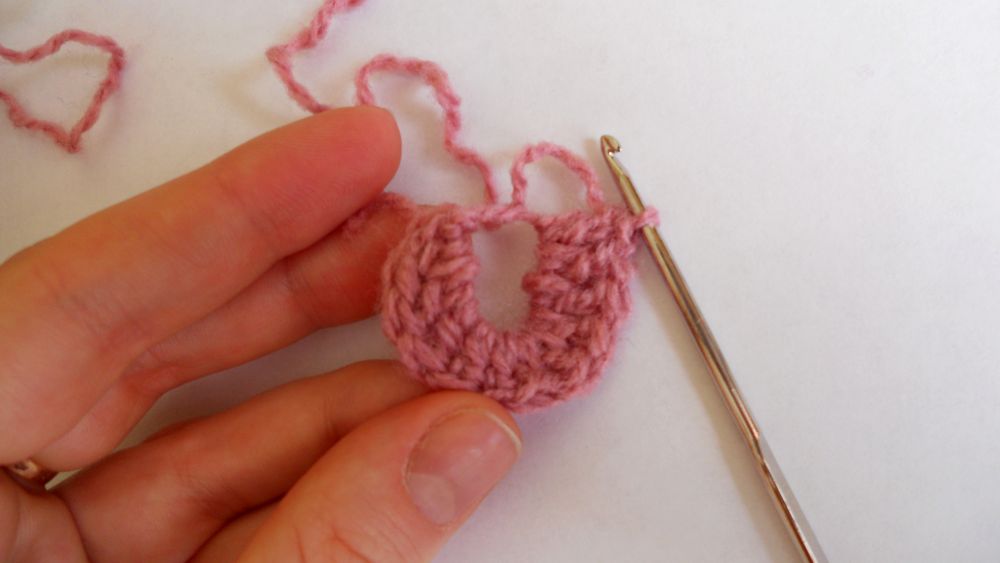
At the second stage, you need to set the desired width of the future sock by circular crochet. Start the second circular row with 3 lifting air loops, then in the same loop, tie another 1 crochet column.
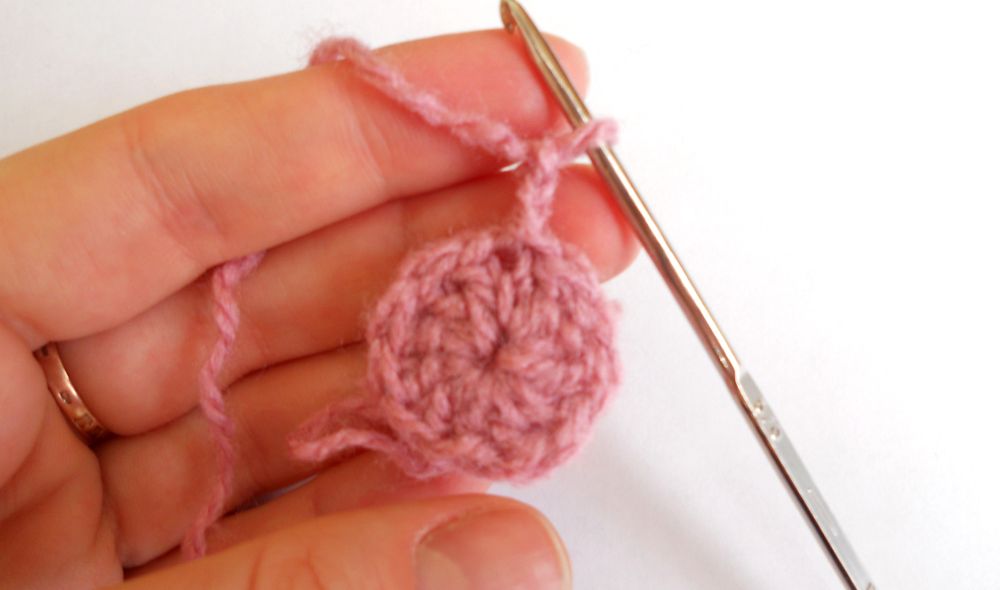
In each remaining loop of the first row, form 2 double crochet columns. The second circular row of knitting will include 24 columns.
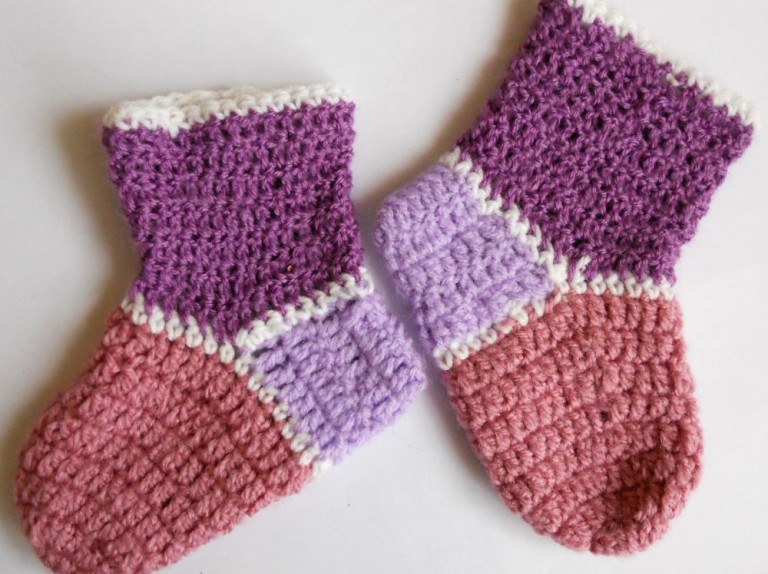
The third circle is similar to the second, but here you should alternate - in one loop of the previous circle, knit 2 crocheted columns, and in the next - one, again two, etc. As a result, the third row of the canvas should include 36 columns.
If the leg is wide enough, then you can further increase the width in the fourth row, by alternating knitting 2 columns with a crochet in one loop, but after 2 single columns, in the end - 48 columns.
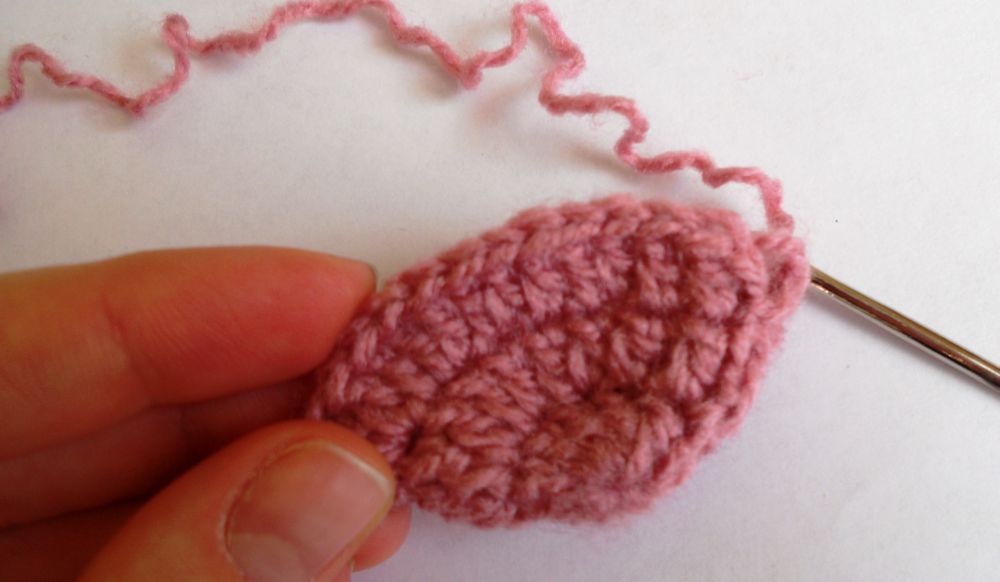
The third stage of knitting is to increase the length of the sock to the place where the heel should be. For the size taken for onsovy, these are 4 rows of circular knitting in each loop of the last row, one crochet without additions.

The next step is to tie the heel. For knitting the heel, you can use yarn of a different color, which will make the product more interesting, also each new transition in colors can be separated in a separate row without lifting loops.
The heel is knitted in a semicircle 4 rows deep in the same stripes, knitted with columns with one crochet in each loop of the bottom row.

Be sure to join the semicircle of the heel with the connecting loops.

The final stage is the combination of the heel and the main canvas of the foot with the subsequent formation of the toe in height.
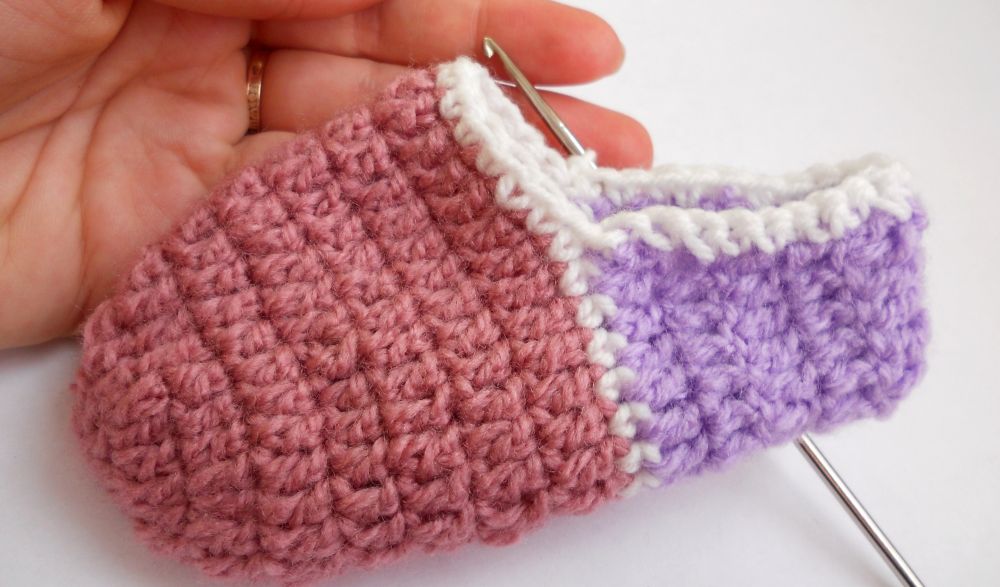
Using a different thread, make columns in a circle with one crochet for each loop of the last row (about 7–9 columns).
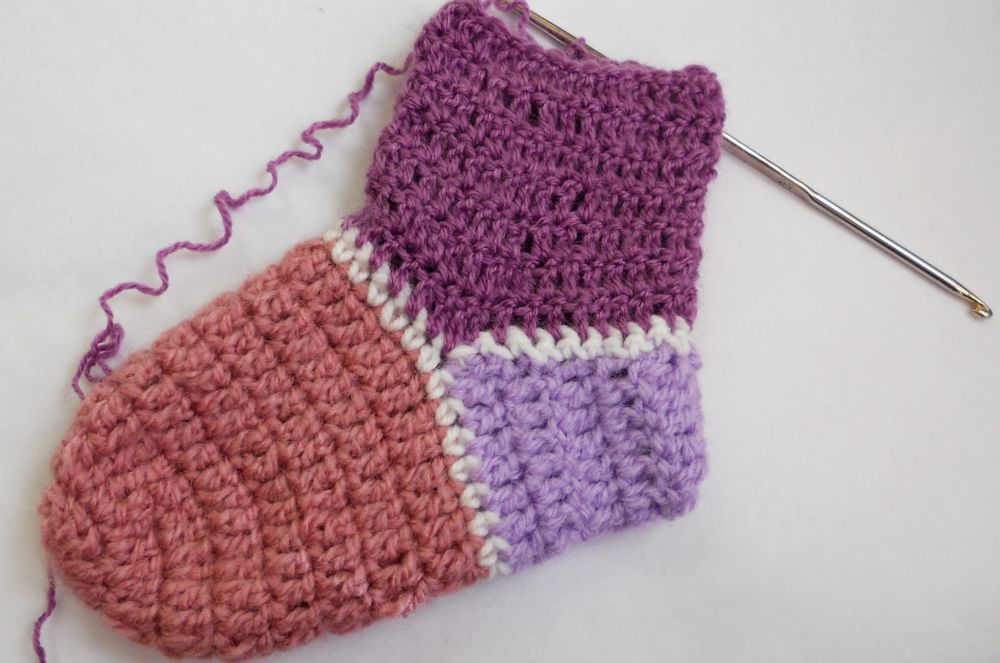
Having completed the last row, you can decorate it with columns without a crochet in a circle.

If the socks are for the girl, in the last row you can make a volumetric frill and sew a bow.
Here's how to crochet baby socks for a young fashionista or fashionista in two free evenings. If you want to do something else with your own hands, look at a master class on knitting a beautiful openwork or make a fashion for yourself.
The master class prepared Olga Volkova specifically for the online magazine "Women's Hobbies."
Even more master classes and ideas are waiting for you in the “Needlework” menu section. Join us on social networks in order not to miss new materials.


